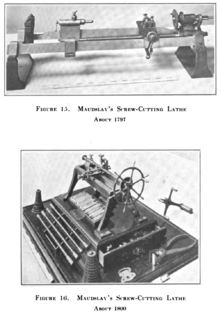Henry Maudslay
Maudslay began work at the age of 12 as a "powder monkey", one of the boys employed in filling cartridges at the Arsenal.
[3] During his time at the Arsenal, Maudslay also worked at the Royal Foundry, where Jan Verbruggen had installed an innovative horizontal boring machine in 1772.
Maudslay acquired such a good reputation that Joseph Bramah called for his services on the recommendation of one of his employees.
Maudslay built the lock that was displayed in Bramah's shop window with a notice offering a reward of 200 guineas to anyone who could pick it.
Maudslay came up with the idea of a leather cup washer, which gave a perfect seal but offered no resistance to movement when the pressure was released.
[3] Maudslay developed the first industrially practical screw-cutting lathe in 1800, allowing standardisation of screw thread sizes for the first time.
[5] This allowed the concept of interchangeable parts (an idea that was already taking hold) to be practically applied to nuts and bolts.
The slide rest was positioned by a leadscrew to which power was transmitted through a pair of changeable gears so that it traveled in proportion to the turning of the work.
In 1797, after having worked for Bramah for eight years, Maudslay was refused a wage increase to 30s a week so he decided to set up his own business.
By 1810, Maudslay was employing 80 workers and running out of room at his workshop, hence moved to larger premises in Westminster Bridge Road, Lambeth.
[3] Following earlier work by Samuel Bentham, his first major commission was to build a series of 42 woodworking machines to produce wooden rigging blocks (each ship required thousands) for the Navy under Sir Marc Isambard Brunel.
The machines were installed in the purpose-built Portsmouth Block Mills, which still survive, including some of the original machinery.
In 1825, Marc Isambard Brunel began work on the Thames Tunnel, intended to link Rotherhithe with Wapping.
[11] In 1791 he married Bramah's housemaid, Sarah Tindel, together they had a daughter Isabel Maudslay[12] and four sons: Thomas Henry, the eldest, and Joseph, the youngest, subsequently joined their father in business.
He was buried in the churchyard of St Mary Magdalen Woolwich; he designed the memorial located in its Lady Chapel.
The machine, which created uniformity in screws and allowed for the application of interchangeable parts (a prerequisite for mass production), was a revolutionary development necessary for the Industrial Revolution.
Maudslay's company was one of the most important British engineering manufactories of the nineteenth century, finally closing in 1904.




